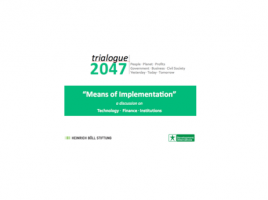Clean Technology Trends and Needs
 In the academic and development sector, clean technologies are defined as those innovations which take care of the people and the planet, are resource efficient, utilise as much waste as possible and emit much lesser carbon dioxide into the atmosphere. If we look at the global trend over the last few decades, then most of the clean technology innovations have been ‘desktop innovations’ focussing on development and application of software and processes. Lack of exposure to the outside world or experience in transforming an innovation into a saleable and marketable product impedes these innovations to see the light of the day. Worth mentioning are use of waste plastic to produce building materials, use of waste hosiery and paper to make handmade paper, waste tyres to produce fuel, pico scale turbines for household energy, energy from the sea waves, potable water from air to name a few.
In the academic and development sector, clean technologies are defined as those innovations which take care of the people and the planet, are resource efficient, utilise as much waste as possible and emit much lesser carbon dioxide into the atmosphere. If we look at the global trend over the last few decades, then most of the clean technology innovations have been ‘desktop innovations’ focussing on development and application of software and processes. Lack of exposure to the outside world or experience in transforming an innovation into a saleable and marketable product impedes these innovations to see the light of the day. Worth mentioning are use of waste plastic to produce building materials, use of waste hosiery and paper to make handmade paper, waste tyres to produce fuel, pico scale turbines for household energy, energy from the sea waves, potable water from air to name a few.
The definition of innovation in clean technology needs to change. At Development Alternatives we believe that innovations should be a form of ‘profitable implementation of creative ideas’. Once the aspect of business and profitability comes into the mind space of innovators, quite a number of ‘basket innovations’ will see the light of the day. It is to be noted that there are quite a number of path-breaking innovations which exist in our rural villages. If these can be explored and fine-tuned, they can really be a game changer in our day to day lives. New reports by Carbon trust has identified major clean tech market opportunities for small businesses in developing countries. It has also been pointed out that the SMEs in developing countries can generate significant growth and create jobs by seizing a potential USD 1.6 trillion market opportunity in clean technology. China is already leading the business with India and the South America and African countries following the footsteps.
Development Alternatives over the last couple of years has been developing some unique products for the construction industry which can cut down the use of virgin resources by more than half. At the same time, they have the potential of using industrial waste materials and reduce CO2 emissions. Most of these are ‘ready to use’ products and do not need any innovative marketing approaches since they are common in our daily lives. Some of the innovative products are high strength, light weight bricks made out of agricultural waste materials. These bricks have a potential to use around 60-70% agricultural waste materials and reduce material consumption of multi-storeyed buildings by around 30%. A low carbon cement has been developed which has the potential to reduce 45-50% of virgin resource materials and at the same time giving equivalent strength compared to normal cements. A low-cost rural refrigeration system has been developed with local materials to increase the shelf life of agricultural products.
The future is for clean technology innovations by the rural entrepreneurs and the SME sector and helping them to productise and bring them to the market.
Soumen Maity
smaity@devalt.org
The views expressed in the article are those of the author’s and not necessarily those of Development Alternatives.




Leave a Reply